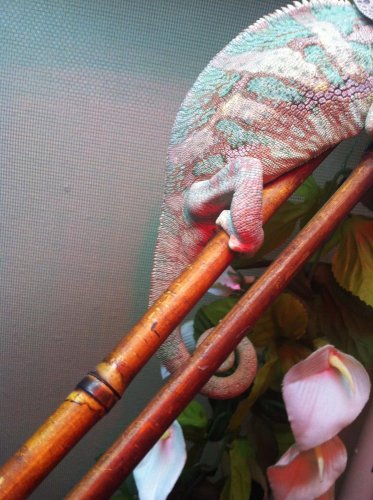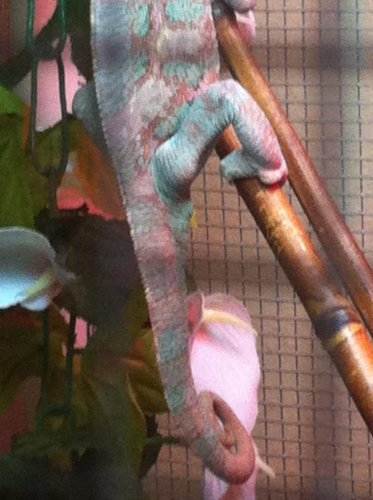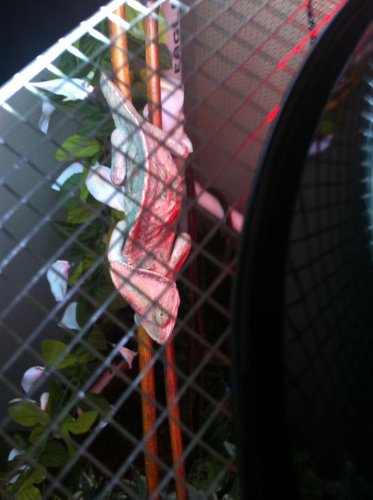Chameleon Info:
* Your Chameleon - Veiled chameleon, male, a little over one year old. We have had him in our care for one year, I think we got him around three months old.
* Handling - At least once daily. He is the type of chameleon who is happier outside of his tank rather than in it, I'm not sure why. His colors are typically much brighter when we hold him, and he likes climbing on us and being held, he does not get scared or aggressive at all. He is very peaceful.
* Feeding - We feed him mealworms and crickets, he stopped eating crickets for a couple months for some reason, but it seems he's gotten his appetite for them back. We typically feed him 5-12 worms (usually around 5), or 2-4 large crickets (usually 2), per day. There is no set schedule, and we try to feed the crickets vegetables and fruits, but they typically just eat the food from the pet store, which claims that it "gut loads" the crickets. He doesn't really like to eat vegetables or fruits himself.
* Supplements - Repti-vite with D3. This is the issue I am worried about - we have been dusting his food with this every other day until I discovered, today, the issues with D3. I am now looking for a calcium supplement without D3.
* Watering - We mist the tank for a few minutes per day, but this does not efficiently get our chameleon to drink. His favorite way to drink is for us to spray water directly into his mouth for about a minute, until he signals that he's done drinking. I don't let him go more than one or two days without doing this, or else I get worried.
* Fecal Description - Our chameleon has never been tested for parasites, but his feces look pretty normal. About a third of the white droppings are yellow, but the rest is white, so I'm not worried about dehydration. The brown part has never looked too runny or strange. Both the white and the brown fecal matter has remained the same since we got him.
* History - No serious health issues at all, from what I can tell. No problems with dehydration, respiration problems, infections (except for some strange bumps on the bottom of his feet that seemed to have gone away after he shed the skin on there), no mouth issues, no infected eyes, no hunger strikes, etc. For our first chameleon he has remained pretty healthy. The only thing I'm worried about is the possibility of MBD or some deformation in one of his legs. We have never taken him to a vet before, but if this issue is serious, we definitely will try to find one and take him.
Cage Info:
* Cage Type - 4 feet tall, 3 feet wide, 3 feet long. My chameleon is only a foot long, including his tail, and I believe he has stopped growing. The cage has two walls which are a type of metal wire, and then two sides which are mesh. He can climb on both fabrics.
* Lighting - For daily lighting, we leave his UVB light on from 7-7, 12 hours, sometimes longer if we take him out for awhile during the day, and we leave his heat lamp on for the day and the night, as it's not super warm where I live. For our UVB we're using a Zilla light fixture. I'm not sure what the bulb is called, but it's very bright and covers most of the top of the cage very well. I know for sure it's not a compact bulb, the tube is very large. As for the heat bulb, I believe it's 60 watts. Oftentimes we let him sunbathe in natural light.
* Temperature - I don't think my chameleon is very picky about temperature range. The bottom of the cage is around 70-80 degrees I believe, and the basking area is 80-90. I only have one thermometer which I use to measure the cool side of the cage. The lowest overnight temp ever would probably be 60-70 degrees F.
* Humidity - Our humidity is very bad. Since we moved our chameleon from a glass tank to a screened cage to help with the air flow, we haven't been able to get the humidity over 30. We're measuring our humidity through a gauge within the cage. The only way to get humidity for us is to spray the tank, which doesn't really work, until we find another solution. Any recommendations would be appreciated!
* Plants - No live plants, only bark at the bottom, some moss, and fake plants.
* Placement - We moved the cage to a warmer spot, so it is no longer near any fans or air vents. There isn't typically much traffic in the area either
* Location - I'm located in the Midwest, USA.
Current Problem - I'm concerned about my chameleon's right leg, as well as his vitamin intake. Because he was only eating worms for awhile, we upped his vitamin intake to make up for the nutrients he was not getting from the crickets or vegetables. I did not realize the Repti-vite had D3, which, after reading forums on here, needs to be limited. I'm not sure if this has anything to do with the growth of his right leg, but it may. We typically give a light dusting of this powder to his food every other day, but since he doesn't have large amounts of food, it's probably equal to how much he'd get from a dusting of 12 crickets once a week, if that makes sense. He doesn't have a huge appetite, so he's not taking in massive amounts of the supplement during his feedings. I'm really worried about what this issue could be. It's as if his right leg is stronger and more "bulky" than the left leg. The joint area is rather large, and when I touch it it feels firm, like a bone or a muscle. There is no weakness of grip, no soft bones, nothing like that. In fact, it seems that his right leg is stronger than his left, as he often uses that one to grab onto things. I don't see how it could be MBD, because his bones seem strong and he can hold onto things well. His grip is EXTREMELY strong, he oftentimes makes us bleed or leaves little holes in our hands from squeezing hard, lol. I'm wondering if anyone can help me with this issue, and also let me know about the D3. I am looking for a calcium supplement without D3 as we speak, and I plan to try gut loading the crickets with fresh foods. I really have no idea what the issue could be - definitely not a lack of calcium since he gets his UVB every day, as well as vitamins every other day. We have never had issues with serious dehydration because we constantly watch his water intake and prompt him to drink water, which he does. I'm including before and after pics so everyone can see the difference and how the right leg is disproportionate. We have only just recently noticed this, so it hasn't been a long-lasting issue. Once again, no serious issues with his health at all, regular sleep schedule, no loss of appetite, still drinking water, climbing and gripping well, doesn't seem to be in pain when I touch the lump. This is my first time ever having a chameleon and I'm only 16, so I don't know as much as others but I'm trying to educate myself. Please help, it is appreciated!
* Your Chameleon - Veiled chameleon, male, a little over one year old. We have had him in our care for one year, I think we got him around three months old.
* Handling - At least once daily. He is the type of chameleon who is happier outside of his tank rather than in it, I'm not sure why. His colors are typically much brighter when we hold him, and he likes climbing on us and being held, he does not get scared or aggressive at all. He is very peaceful.
* Feeding - We feed him mealworms and crickets, he stopped eating crickets for a couple months for some reason, but it seems he's gotten his appetite for them back. We typically feed him 5-12 worms (usually around 5), or 2-4 large crickets (usually 2), per day. There is no set schedule, and we try to feed the crickets vegetables and fruits, but they typically just eat the food from the pet store, which claims that it "gut loads" the crickets. He doesn't really like to eat vegetables or fruits himself.
* Supplements - Repti-vite with D3. This is the issue I am worried about - we have been dusting his food with this every other day until I discovered, today, the issues with D3. I am now looking for a calcium supplement without D3.
* Watering - We mist the tank for a few minutes per day, but this does not efficiently get our chameleon to drink. His favorite way to drink is for us to spray water directly into his mouth for about a minute, until he signals that he's done drinking. I don't let him go more than one or two days without doing this, or else I get worried.
* Fecal Description - Our chameleon has never been tested for parasites, but his feces look pretty normal. About a third of the white droppings are yellow, but the rest is white, so I'm not worried about dehydration. The brown part has never looked too runny or strange. Both the white and the brown fecal matter has remained the same since we got him.
* History - No serious health issues at all, from what I can tell. No problems with dehydration, respiration problems, infections (except for some strange bumps on the bottom of his feet that seemed to have gone away after he shed the skin on there), no mouth issues, no infected eyes, no hunger strikes, etc. For our first chameleon he has remained pretty healthy. The only thing I'm worried about is the possibility of MBD or some deformation in one of his legs. We have never taken him to a vet before, but if this issue is serious, we definitely will try to find one and take him.
Cage Info:
* Cage Type - 4 feet tall, 3 feet wide, 3 feet long. My chameleon is only a foot long, including his tail, and I believe he has stopped growing. The cage has two walls which are a type of metal wire, and then two sides which are mesh. He can climb on both fabrics.
* Lighting - For daily lighting, we leave his UVB light on from 7-7, 12 hours, sometimes longer if we take him out for awhile during the day, and we leave his heat lamp on for the day and the night, as it's not super warm where I live. For our UVB we're using a Zilla light fixture. I'm not sure what the bulb is called, but it's very bright and covers most of the top of the cage very well. I know for sure it's not a compact bulb, the tube is very large. As for the heat bulb, I believe it's 60 watts. Oftentimes we let him sunbathe in natural light.
* Temperature - I don't think my chameleon is very picky about temperature range. The bottom of the cage is around 70-80 degrees I believe, and the basking area is 80-90. I only have one thermometer which I use to measure the cool side of the cage. The lowest overnight temp ever would probably be 60-70 degrees F.
* Humidity - Our humidity is very bad. Since we moved our chameleon from a glass tank to a screened cage to help with the air flow, we haven't been able to get the humidity over 30. We're measuring our humidity through a gauge within the cage. The only way to get humidity for us is to spray the tank, which doesn't really work, until we find another solution. Any recommendations would be appreciated!
* Plants - No live plants, only bark at the bottom, some moss, and fake plants.
* Placement - We moved the cage to a warmer spot, so it is no longer near any fans or air vents. There isn't typically much traffic in the area either
* Location - I'm located in the Midwest, USA.
Current Problem - I'm concerned about my chameleon's right leg, as well as his vitamin intake. Because he was only eating worms for awhile, we upped his vitamin intake to make up for the nutrients he was not getting from the crickets or vegetables. I did not realize the Repti-vite had D3, which, after reading forums on here, needs to be limited. I'm not sure if this has anything to do with the growth of his right leg, but it may. We typically give a light dusting of this powder to his food every other day, but since he doesn't have large amounts of food, it's probably equal to how much he'd get from a dusting of 12 crickets once a week, if that makes sense. He doesn't have a huge appetite, so he's not taking in massive amounts of the supplement during his feedings. I'm really worried about what this issue could be. It's as if his right leg is stronger and more "bulky" than the left leg. The joint area is rather large, and when I touch it it feels firm, like a bone or a muscle. There is no weakness of grip, no soft bones, nothing like that. In fact, it seems that his right leg is stronger than his left, as he often uses that one to grab onto things. I don't see how it could be MBD, because his bones seem strong and he can hold onto things well. His grip is EXTREMELY strong, he oftentimes makes us bleed or leaves little holes in our hands from squeezing hard, lol. I'm wondering if anyone can help me with this issue, and also let me know about the D3. I am looking for a calcium supplement without D3 as we speak, and I plan to try gut loading the crickets with fresh foods. I really have no idea what the issue could be - definitely not a lack of calcium since he gets his UVB every day, as well as vitamins every other day. We have never had issues with serious dehydration because we constantly watch his water intake and prompt him to drink water, which he does. I'm including before and after pics so everyone can see the difference and how the right leg is disproportionate. We have only just recently noticed this, so it hasn't been a long-lasting issue. Once again, no serious issues with his health at all, regular sleep schedule, no loss of appetite, still drinking water, climbing and gripping well, doesn't seem to be in pain when I touch the lump. This is my first time ever having a chameleon and I'm only 16, so I don't know as much as others but I'm trying to educate myself. Please help, it is appreciated!





